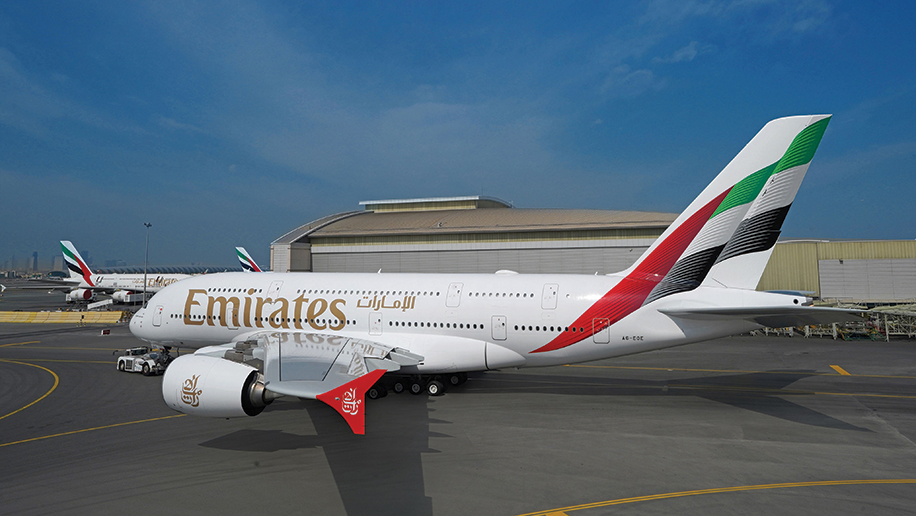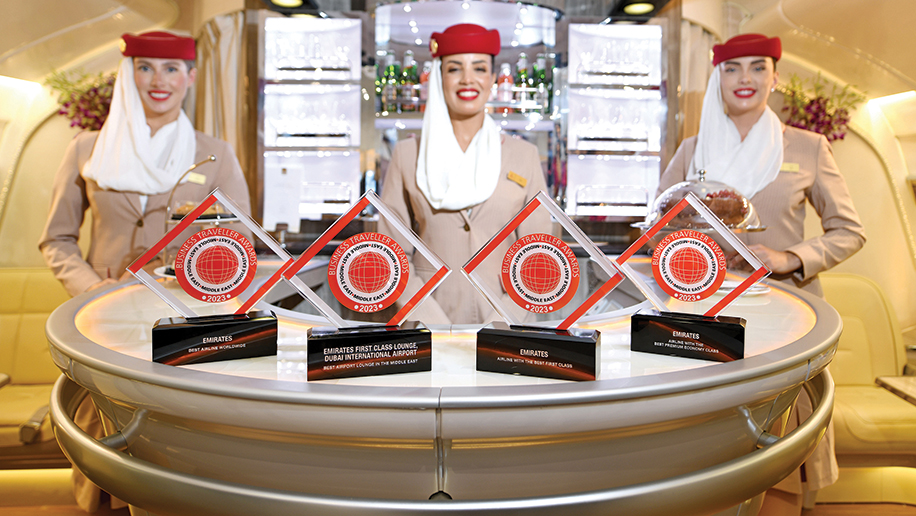
To swing from a US$1.1 billion loss, to a US$2.9 billion profit in a span of 12 months is no trivial feat. When Emirates posted its annual profit for the financial year of 2022-2023 ending March 31, 2023, it noted that revenue too was up 81 per cent to US$29.3 billion, thereby indicating the full scale of the recovery it had made from the pandemic-induced losses it incurred the year prior. This, mind you, was achieved in the midst of consistently high oil prices, soaring inflation rates globally that squeezed recreational travel, and a conflict in East Europe that has impacted travel corridors between Europe and Asia.
Still, the airline carried 43.6 million passengers through the 2022-2023 period, a 123 per cent increase year-on-year. Its seat capacity was also up 78 per cent. “From a demand perspective, we’re exceeding pre-Covid levels,” Emirates Airline’s chief commercial officer, Adnan Kazim, told Business Traveller in an exclusive interview along the sidelines of the recently concluded Arabian Travel Market. Kazim said that the momentum for the airline began with last year’s summer season and sustained right through February which is generally considered the low season for travel. “To reflect that, we ramped up the capacity to 80 per cent by the end of the financial year in March this year, and we’re moving towards 90 per cent by this summer, before ending this financial year at 95 per cent. By the start of the next financial year, we should be reaching the 100 per cent mark,” says Kazim.
The airline is currently flying to approximately 140 destinations. One of the major markets that it is poised to focus on in the coming years, he says, is North America. To that end, Emirates recently activated its codeshare with United. Emirates flies to three hubs in the US – Chicago, Houston and San Francisco. By way of the codeshare, Emirates passengers can access more than 150 US cities in the United network via those three gateways. Due to an interline agreement between the two carriers, Emirates passengers can also choose from dozens of more destinations outside of the US in Canada, Mexico, the Caribbean, and Central and South America via the three hubs.

Towards the end of last year, Emirates also activated a codeshare with Canada’s largest carrier, Air Canada, to provide customers access to 46 points across the North American, Asian, Middle Eastern and African markets. Emirates customers can therefore book codeshare flights to and from Canadian points beyond Toronto, including Montreal, Calgary, Edmonton, Vancouver, Halifax and Ottawa.
“We have a solid partnership with United and Air Canada, two giant companies that have massive networks in the US and Canada. It opens new opportunities to enter many markets that were not feasible for us to operate. With Air Canada by our side, we have managed to add Montreal to our operations because Montreal is a hub for Air Canada from where 40 per cent of its capacity and deployment of flights takes place. Likewise, Air Canada is coming in from Vancouver to Dubai with the full cooperation of Emirates,” says Kazim in reference to the announcement that Air Canada made regarding its four times weekly nonstop flights between YVR and DXB which will commence in October.
“As for United, we already launched a codeshare for 150 destinations and that number will ramp up to about more than 400 interline and codeshare destinations in the future. Our upcoming A350 aircraft with a 300-seater capacity and a range of up to 15 hours will be ideal for expansion into the Americas.”
A sprawling network
As of the end of March this year, Emirates had a fleet of 260 aircraft. It currently has orders for 50 Airbus A350s, 117 Boeing 777Xs and 30 Boeing 787-9s. At a roundtable at the 79th annual general meeting of the International Air Transport Association in Istanbul in June, Emirates’ president, Tim Clark, indicated that the airline might order additional A350s, Boeing 777-9s or even Boeing 787s, without confirming a timeframe or size of that potential order.
For now, the superjumbo A380 remains its flagship aircraft. The first Emirates A380 entered into service in 2008, while the final one – its 123rd – was delivered in December 2021. With demand creeping up, Emirates is rolling out that aircraft onto a greater number of routes. “We have 85 A380s operating today, and that number will jump up to 90 before the end of summer and to 95 by the end of the financial year. As far as the network deployment is concerned, the A380 has already been deployed to 43 points. This number will increase to 50 before the end of summer as we deploy it to Taipei, Bali, Shanghai, Beijing, Nice and Birmingham,” says Kazim.
Emirates is bullish about the prospects of two new additions to its fleet over the coming months by way of its Airbus A350 and Boeing 777x widebody long-range fuel-efficient aircraft. “We have a lineup of aircraft that will start to come into the fleet in August 2024. We have an order for 50 A350s which will start entering the fleet in the next financial year, and the delivery of those will be completed over three-and-a-half years. Those 50 aircraft will be divided into two different sub-fleets. One is for regional operation within a range of seven-eight hours and can reach places in Africa, the Middle East, Europe and Asia. The second sub-fleet of the A350s will head towards destinations that are more than ten hours away from Dubai.
“The year after [the A350 begins to enter the Emirates fleet], we have the Boeing 777x entering in phases. Those aircraft will partly replace our older [Boeing 777] ER, but partly also add to our fleet expansion,” observes Kazim. He says that all of the airline’s Boeing 777 fleet – more than 130 of them – are currently deployed.
While aircraft acquisition is underway, Emirates has also embarked on a massive fleet retrofit project that will focus on around 120 of its existing aircraft including 67 A380s and 53 777s. The US$2 billion project that began towards the end of last year will be completed by 2025. The carrier has prioritised the retrofitting of its earmarked A380s after which it will focus on its 777s. Overall, it includes refurbishing 728 first class suites, upgrading more than 5,000 business class seats and installing 4,000 of the airline’s new premium economy seats. On average, two-and-a-half aircraft are being retrofitted each month. Emirates’ determination to refresh the look and feel as well as the user experience on-board its aircraft has meant that it has also invested more than US$350 million on the in-flight experience in its upcoming A350 fleet by selecting the Thales’ AVANT Up system which features 4K QLED HDR displays, two Bluetooth connections and built-in wifi for passengers to pair multiple devices to it.

Perhaps the most significant change coming to the airline is the increasing presence of its premium economy class which it first showcased in 2022. The carrier began by fitting the premium economy into six A380 aircraft which it deployed to London, Paris and Sydney. “When we planned the premium economy, we had in mind flights that exceeded six hours so that we could get the full benefit from the economics of it and also that the consumer would get the full benefit from the comforts of it. Today, we have 12 aircraft with premium economy class and as the retrofit programme continues, we will have 17 more aircraft with premium economy seats by the end of this summer. Flights with the premium economy cabin are being operated to London, Sydney, Melbourne, Christchurch, Auckland, JFK, San Francisco, Singapore and Houston.
“One of the concerns we had at one stage with premium economy is that it might cannibalise traffic from business class. Instead, what we had was traffic from the economy class shifting towards premium economy. The aim is to get the premium economy into 65 per cent of our network,” reveals Kazim.
Broadening horizons
In January this year, Emirates reached a milestone when it conducted its first flight with 100 per cent sustainable aviation fuel (SAF) in one engine of a B777-300ER. While the results of that flight are encouraging, Kazim cautions as to ongoing concerns with the availability of SAF and also the exorbitant price of it. It is currently nearly six-eight times more expensive than it should be for it to become a commercially viable option, he says. Consequently, in May, Emirates said it had committed US$200 million to fund R&D projects that seek to reduce the impact of fossil fuels in commercial aviation.

Apart from addressing the issue of sustainability, the airline – like its peers – is also facing challenges in other areas. Kazim references the situation in Ukraine, as well as the constant manoeuvrings around strikes called for in European cities and the occasional lack of skilled labour to support ground operations outside of Dubai. “If tomorrow, for example, Emirates wants to add frequencies and capacity in certain markets, it’s not as easy as it used to be. That’s because either the capacity of the airports have not fully resumed to 100 per cent or maybe even their ground handling departments don’t have efficient manpower to cope with the growth at that airport,” says Kazim while adding that it might take another two years for the situation overall to stabilize and adapt to the current scenario.
Those challenges don’t seem to be weighing down the airline as it posted record profits earlier this year. “People are desperate to travel, they want to get to a different destination. That has helped the situation for us. We already increased our Available Seat Kilometres (ASKM) by 31 per cent just to meet this summer’s high demand,” notes Kazim. At this rate, come March next year, the figures that come out from the airline might reveal that its winning streak hasn’t let up after all.












